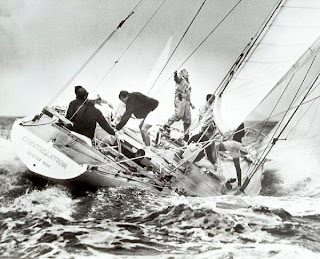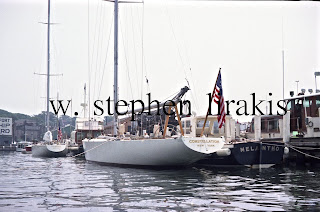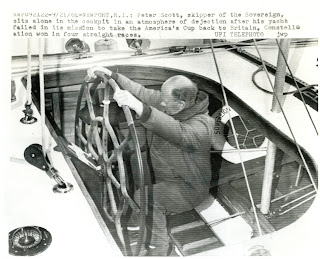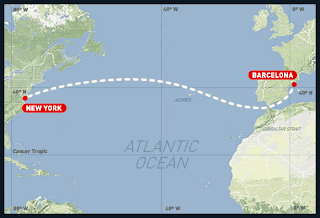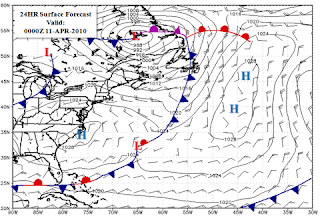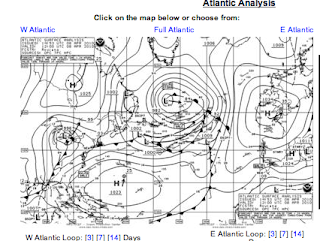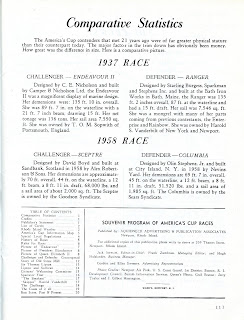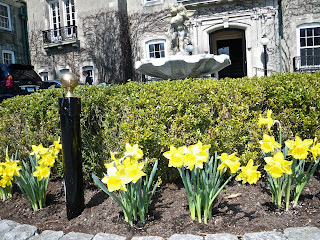The color photos are courtesy of Dick Enersen, crew of “Constellation” in 1964. Each photo is a story in itself. Dick looking very young indeed under the Connie shed sign. The final photo of Eric Ritter the helmsman, who stepped aside in the interest of the boat, greeting Harry Morgan, head of the selection committee bringing the good news that “Constellation” has been selected to defend.
The black and white photo I believe was taken on a day when most of the other 12 meters lost their masts.
I would like to hear from more of the crews out there. Thankyou Dick.
Category: NYYC
12 days 6 hours 3 minutes 48 seconds
Another look at the 1964 summer
Looking back from today’s perspective makes the gear and sails in particular look primitive. I is hard to imagine that the 12 meters of the era were the cutting edge of sailing. Look at the boom vang in the earlier post. The mainsheet winch, practically the smallest winch on the boat for the largest sail; and four parts. Just think what that must have been like at the leeward mark.
Hanks were still used on headsails. I believe an argument could be mounted defending hanks, tactically, look at the photo of the bow of “Constellation”, Buddy Bombard is standing in the forward hatch, a jib would be stopped and hoisted through this hatch; sheets attached, at a leeward mark, a boat could carry the spinnaker right to the mark, breaking out the genoa at the last possible moment.
Wooden boats built to lloyd’s scantlings. Designers and builders did what they could to save weight. I would not be until 1974 when aluminum would be allowed and 1986 when the first fiberglass 12 meters came into being.
Weather, was not much beyond the farmer’s almanac. Statics accumulated over time were the only analysis available.
Ash blocks with bronze bearings were still common. Lines were still large and heavy. Change came slowly
America’s Cup 1964
With each new challenge the design race increased. “Constellation” the newest Sparkman&Stephens design was only second best entering the August trails. “American Eagle” the Bill Luders design and build, was up 21 and zero, appearing unbeatable and in the difficult position of not having lost a race; not knowing what if anything to change.
Eric Ridder stepped aside as skipper of “Connie”being replaced by Bob Bavier. Along with a few other changes and she went on to be selected to defend. Leaving Bill Cox the skipper of “American Eagle” stunned.
The American trials were the highlight of the summer, the English challenger “Sovereign” was hopelessly outclassed.
Olin Stephens, I believed, liked to make small incremental changes, As the season of 1967 would show; “Constellation” exhibited some of the genes that would become “Intrepid”.
The energy and enthusiasm ratcheted up with each challenge. The world was emerging from World War II, coupled with that was the easing of Taxes on the rich. America was truly on top of the world; and feeling that way.
There are more stories connected with the summer of 1964 and this challenge deserves more time.
Never underestimate LUCK
The W60 on which Peter Becker is sailing was hit by a errant wave. It is just one of those things. Look forward, there will be another weather window to fix the damaged rudder. Press on. Just think how the people at Goldman Sachs are feeling today.
TRANSATLANTIC 2011
The Transatlantic race has been announced starting from Newport in June, 2011 finishing in Cowes, IOW, England. I expect the plan is to encourage boats to later sail Cowes week and the Fastnet race. For those who would then like to continue sailing, get the boats to the Mediterranean, for the Middle Sea Race in October.
I have already heard from several people who intend to compete. Those who love to go to sea. There is quite a difference between a 3-4 day Bermuda race ( 24-36 hours for the really big boats including the Volvo 70) and a 14-18 day transatlantic race.
For those who just want to have fun I had attached the file below. This is real LA. what more is there to say.
Estralla Damm sails 450 miles in 24 hours
The W 60’s still have their collective foot on the accelerator. However I believe they are a little further north than they might wish to be. As the saying goes: “what goes up, must come down”. Depending on the weather, they might have boxed themselves into a corner. They need the wind to back so they can jibe. If it heads, they can work down, but they would much rather be freed up than on the wind. Equally, they will be sailing extra distance, which is fine if they can keep up this pace.
Estrella Damm & W Hotels are off
The Two W 60’s have set off from New York heading to Barcelona The 500 mb forecast shows promise. these boats are quick enough to keep up with the system at least for a while. It is always an advantage to be able to choose your departure time; never-the-less I envy Peter Becker and Stan Schreyer.
America’s Cup 1958
It is important to put 1958 in historical context. This was the first challenge for the America’s Cup since 1937; when it was raced for in “J” class yachts, around 130 feet in length. Life was different, a depression, a world war, taxes were higher than today, for the wealthy.
Olin Stephens had designed “Vim” for Harold Vanderbilt in 1939 (sail # 15) “Columbia” (sail # 16) built in 1958 both at Nevins’ yard in City Island. “Vim” pressed “Columbia” and made the selection committee’s job a hard one.


